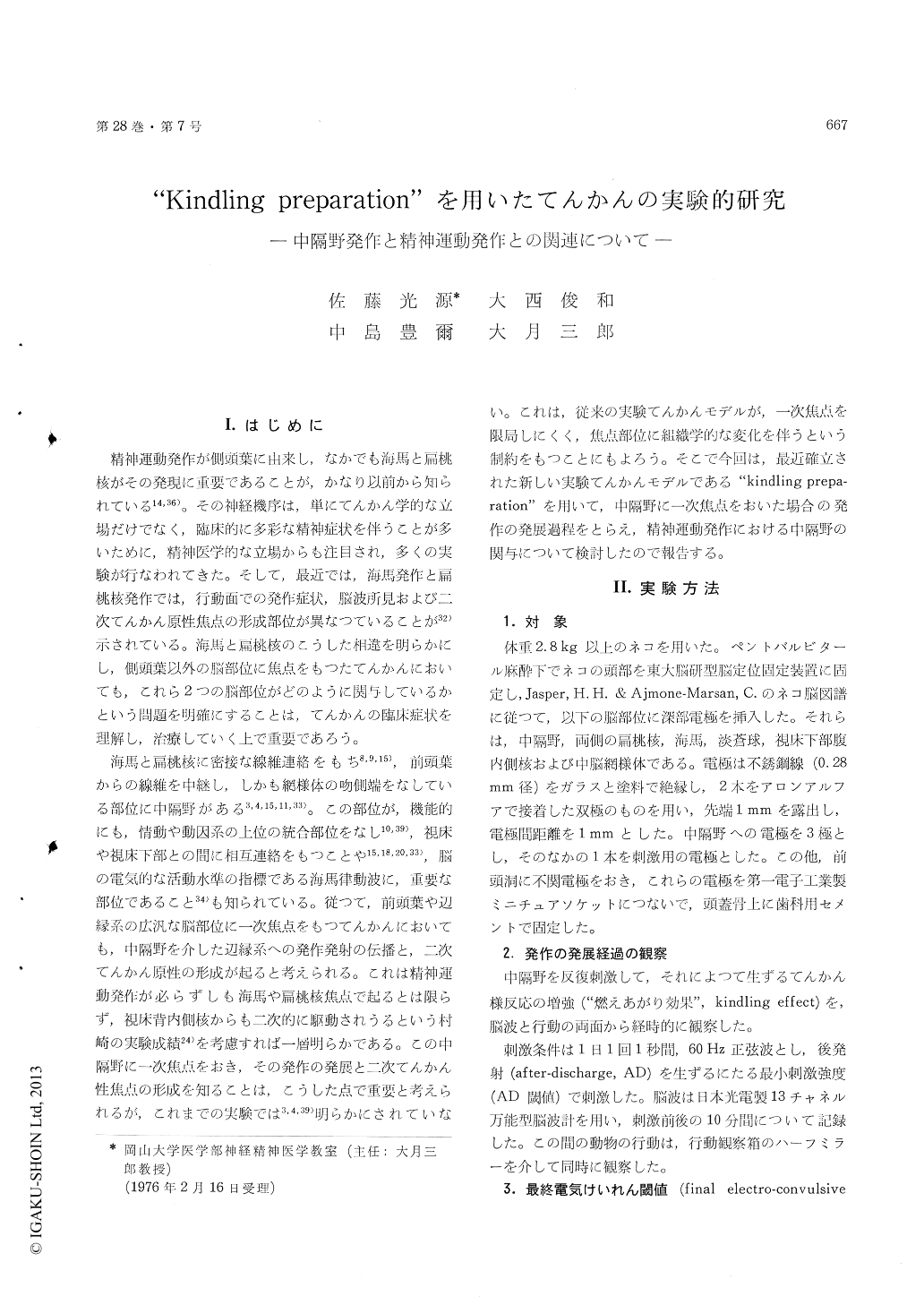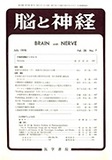Japanese
English
- 有料閲覧
- Abstract 文献概要
- 1ページ目 Look Inside
I.はじめに
精神運動発作が側頭葉に由来し,なかでも海馬と扁桃核がその発現に重要であることが,かなり以前から知られている14,36)。その神経機序は,単にてんかん学的な立場だけでなく,臨床的に多彩な精神症状を伴うことが多いために,精神医学的な立場からも注目され,多くの実験が行なわれてきた。そして,最近では,海馬発作と扁桃核発作では,行動面での発作症状,脳波所見および二次てんかん原性焦点の形成部位が異なつていることが32)示されている。海馬と扁桃核のこうした相違を明らかにし,側頭葉以外の脳部位に焦点をもつたてんかんにおいても,これら2つの脳部位がどのように関与しているかという問題を明確にすることは,てんかんの臨床症状を理解し,治療していく上で重要であろう。
海馬と扁桃核に密接な線維連絡をもち8,9,15),前頭葉からの線維を中継し,しかも網様体の吻側端をなしている部位に中隔野がある3,4,15,11,33)。この部位が,機能的にも,情動や動因系の上位の統合部位をなし10,39),視床や視床下部との間に相互連絡をもつことや15,18,20,33),脳の電気的な活動水準の指標である海馬律動波に,重要な部位であること34)も知られている。従つて,前頭葉や辺縁系の広汎な脳部位に一次焦点をもつてんかんにおいても,中隔野を介した辺縁系への発作発射の伝播と,二次てんかん原性の形成が起ると考えられる。これは精神運動発作が必らずしも海馬や扁桃核焦点で起るとは限らず,視床背内側核からも二次的に駆動されうるという村崎の実験成績24)を考慮すれば一層明らかである。この中隔野に一次焦点をおき,その発作の発展と二次てんかん性焦点の形成を知ることは,こうした点で重要と考えられるが,これまでの実験では3,4,39)明らかにされていない。これは,従来の実験てんかんモデルが,一次焦点を限局しにくく,焦点部位に組織学的な変化を伴うという制約をもつことにもよろう。そこで今回は,最近確立された新しい実験てんかんモデルである"kindling prepa—ration"を用いて,中隔野に一次焦点をおいた場合の発作の発展過程をとらえ,精神運動発作における中隔野の関与について検討したので報告する。
The seizure development was investigated in seven septal kindled cats for examining a participation of septal area in psychomotor epilepsy. Daily elec-trical stimulation (mean: 33.5 days) of septal area could lead to the "kindled" generalized convulsion.Six stages of behavioral seizure development were distinguished: 1) attention reaction, 2) the above and immobility, 3) the above and autonomic mani-festation, 4) the above and facial twitching, head nodding, 5) the above and tonic extension of con-tralateral forepaw, 6) the above and generalized clonic convulsions.
Self-sustained after-discharge and independent interictal spike discharge appeared in the hippo-campus in stage 2 or 3, in the amygdala and the globus pallidus in stage 3 or 4, and also in the ventromedial hypothalamic nucleus in stage 5. Positive transference phenomenon was confirmed inbilateral hippocampus, amygdala and globus pallidus. These findings show the progressive dissemination of secondary epileptogeneses in these secondary brain structures during the septal seizure develop-ment. Electrographic and behavioral seizure development mentioned above were completely identical to those in the hippocampal seizure that we have reported previously. It is concluded that psychomotor epilepsies may not only be triggered by the hippocampal and amygdaloid foci but by the septum and its related structuresfoei.

Copyright © 1976, Igaku-Shoin Ltd. All rights reserved.


